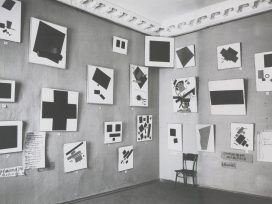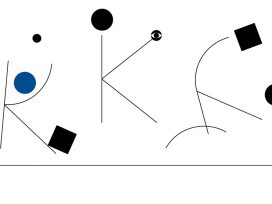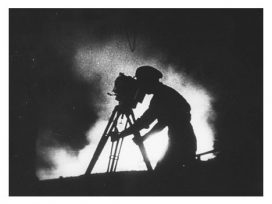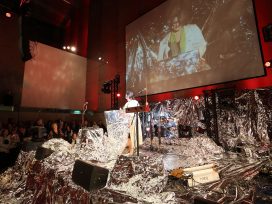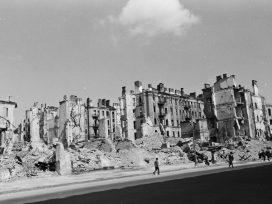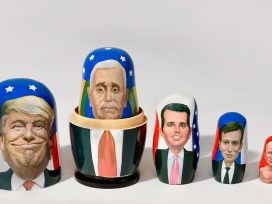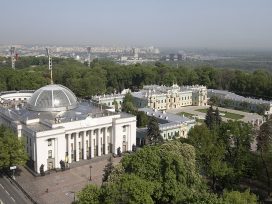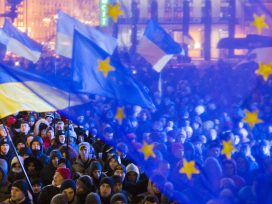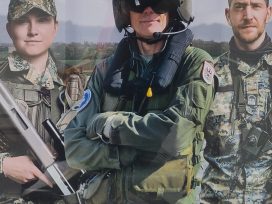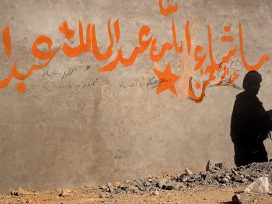Maidan set art free from the fight for the political agenda, since everything has become a part of the political agenda. On the other hand, the rapidly accelerating political and geopolitical changes brought several challenges for artists.
On 9 May 2019, during the opening of the 58th Venice Biennale, the world’s largest cargo plane was supposed to fly over the city. Mriya (also known as ‘The Dream’, or technically the Antonov An-225), was meant to soar above the Giardini, the main area for the Biennale’s national pavilions, casting a shadow. On board would have been a hard drive with a registry of all 1,143 Ukrainian artists who had responded to the curators’ call and submitted their basic info through a Google form. The flight was meant to be an opening performance for the Ukrainian Pavilion, which would take place not on any other day but 9 May — ‘Victory Day’, highly symbolic in the post-Soviet memory realm.
At 1PM, everyone who knew about the performance turned their heads and phones toward the sky. Some even claimed they saw the plane flying high overhead; there are photos and videos. But the Mriya didn’t actually fly.
This flight was unfeasible from the very beginning, incapacitated by flight restrictions over the UNESCO heritage city; the weather conditions necessary to cast a shadow; and the need to get the agreement of the Antonov Company, which developed, built, and owns the plane, to name just a few. But most important of all was the fact that dreams rarely come true. That is what makes them so desirable.
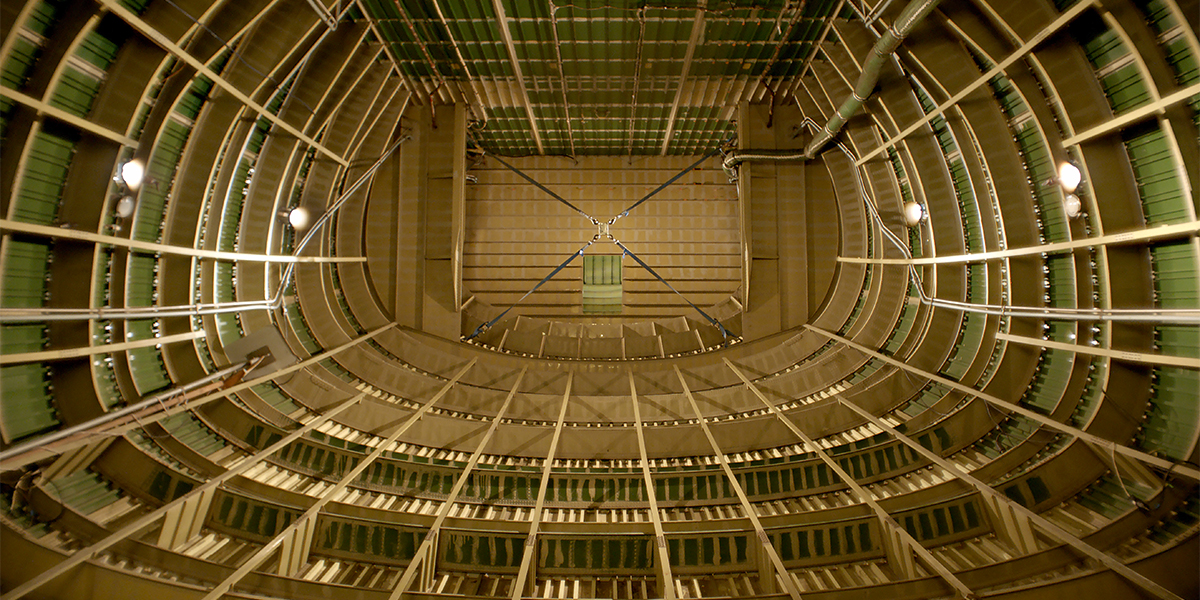
A hard disc carrying information about Ukrainian artists was placed in the tail part of the AN-225 “Mriya” aircraft. Photo via focus.ua.
In the Ukrainian Pavilion itself (located in the corner of another of the Biennale’s main locations, at the Arsenale), dreams of the flight that never happened were narrated by several performers. Through a combination of real stories, rumours, and gossip surrounding the project, the performers were, in fact, telling other, quite contradictory, stories.
These were about the dream of being an important, recognized country — even if only because Ukraine had produced the world’s largest cargo plane — rather than problematic losers at the margins of Europe. The dream of having a proper, even if elusive, place among all other countries whose pavilions have long been part of the big Venice vanity show, unlike Ukraine. The dream was to write the name of the country and its artists into the history of global contemporary art, which as yet has little place for Ukrainians. These stories were also stories about the naïveté of these dreams, as well as those of a supposedly egalitarian art world in which everybody is an artist, or dreams of a world in which the duty to fight for a country’s symbolic value is bestowed upon artists since politicians fail to do so (and if artists don’t succeed, they should be held responsible for misuse of public funds, just as politicians should be).
‘The Shadow of a Dream cast upon Giardini della Biennale’, the flight that never happened, located a short walk-through off space in the building adjacent to the Arsenale. Poorly designed visuals that make the Pavilion practically unnoticeable; performers who are tired or often bored, or just out for a smoke break; the complexity of the context, too complicated and irrelevant to the majority of the hurrying Biennale audiences — what was it all about? Was it about the belief that dreams are more important than mundane reality? Or was it reflecting the fact that dreams create utopias, places that do not exist, that fail to be real? Was there self-irony about the (im)possibility of being a failed pavilion to the extent it is (im)possible to be a failed state, because who is there to know the past and the future and, therefore, who is there to judge? Or was this project built on the conviction that articulating stories of aspirations and losses, dreams and failures, hopes and reality is what art has to do to make the complexity and innate inner contradictions of any context thinkable and thus livable? Or was it an excruciating comment on the feeble role of art in ‘interesting times’, as last year’s Biennale theme proclaimed?
2013
The Venice Biennale may often fail to rise to the high expectations of the audience and critics, or to present robust and coherent curatorial projects, but it never fails to display the geopolitical aspirations and cultural clashes of its participating national pavilions.
Ukraine’s first pavilion after the Maidan events of 2013-2014 and the beginning of the war in the east of the country was called ‘Hope!’ (2015). It was placed as a temporary transparent structure, presenting works of seven artists and art collectives, on the shore of the Venice lagoon between Arsenale and Giardini, in a ‘no man’s land’ outside the main exhibition locations but unmissable for anyone walking between them. Last year’s project reference to ‘the dream’, hidden in the fringes of Arsenale, created a perfect symbolic framework to think about Ukrainian art in the post-Maidan age. But what makes it possible to divide history into pre- and post-Maidan? Is it even feasible, or is this only an imaginary division?
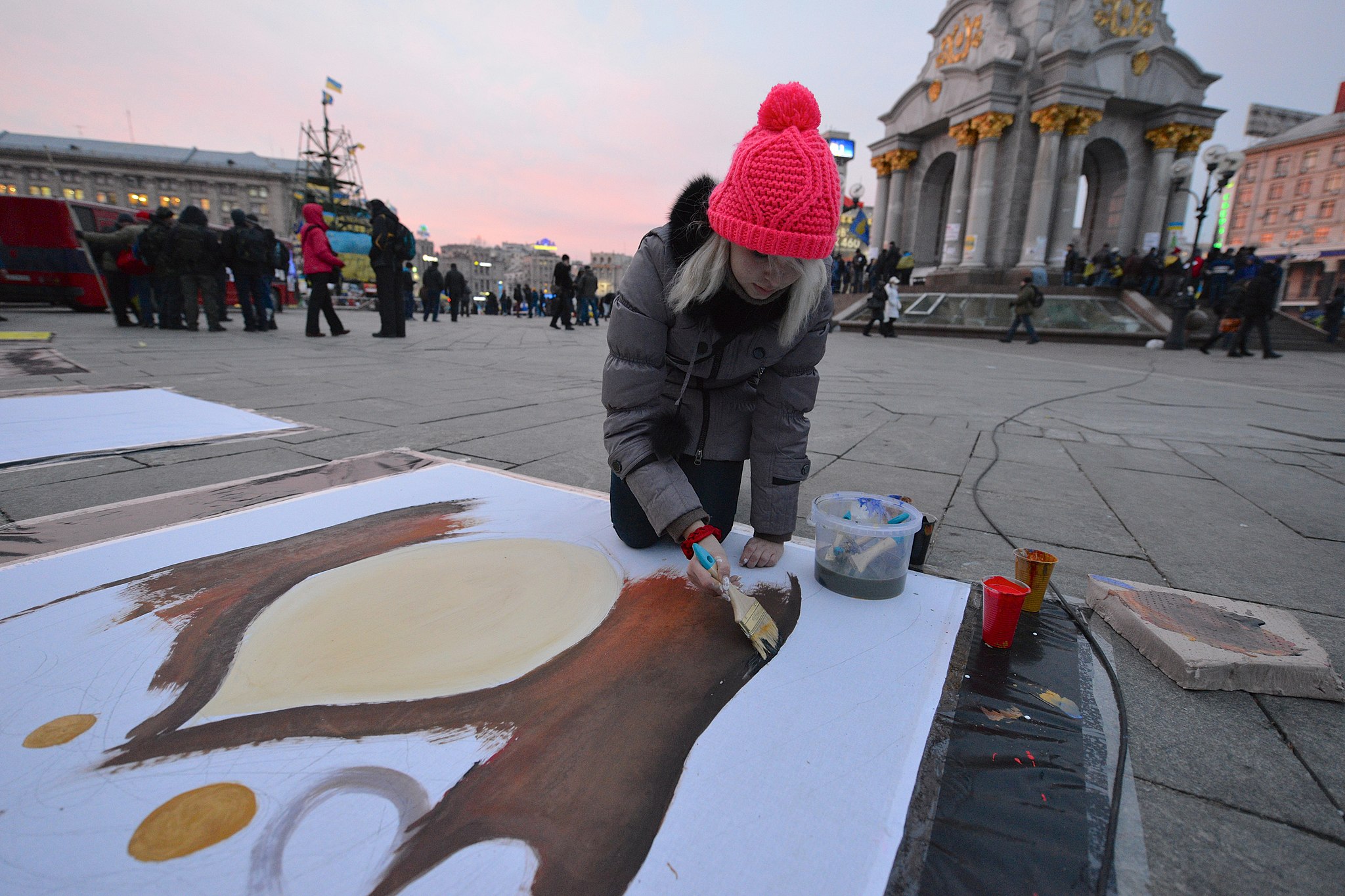
An art project in support of Euromaidan. Photo by Ivan Bandura from Wikimedia Commons.
Maidan, or the Ukrainian ‘Revolution of Dignity’, was predetermined to become a symbolic event, as any large-scale public revolt or even revolution would be. Moreover, like any other historic symbol, it has slowly become saturated with emotions, legends, associations, memories, and visions. In a way quite similar to the real or Velvet revolutions of the twentieth century, Maidan embodied a temporal break: a rupture between the present which looked and functioned very much like the past, and felt ever more irrelevant and suffocating; and the ‘post-present’, the new time free from the limitations of the past and open to a better future.
Moreover, and very much in sync with Jürgen Habermas’s concept of the ‘catch-up revolution’, it was moved by a belief in the existence of a right and proper time flow that the country needed to get back to or, rather join. What other post-communist countries of the former Eastern bloc had attempted in 1989 – to return to their ‘hijacked’ histories through freezing or eliminating memories of the last half-century, thereby joining the flow of European history and political space –, Ukraine was trying to do in 2014. The whirlpool of euphoria triggered by the hope for rapid, fundamental change, sudden unity and community formed against internal enemies; then, when the war broke out, foreign ones, and the slow approach of weariness, helplessness and frustration. It is easier to observe history from a distance than to live through it.It’s quite tempting to describe Maidan in terms of ‘generation change’. However, it was neither a generational peak moment, like 1968, and nor it had raised a generation, like 1989. What it did was create a cross-generational trend — a signifier, which we can call vast social engagement in a context that had become highly politicized. After 2014, politics stopped being a ‘dirty business’ exclusively for politicians. It became a matter of civic engagement, even a duty at times. Following the old and long overdue feminist slogan of the 1960s, the personal became political and politics became open to everyone. Yet in the context of contemporary art, being political had already been a challenge for a decade at that point.
2004
In Ukraine, political art had been slowly building momentum since 2004, triggered by the Orange Revolution, mass protests against electoral manipulation that ultimately brought Viktor Yushchenko to power. At that time, however, the very concept of political art itself was contested. The issue of the ‘political’ was a taboo of sorts in the Ukrainian context. Politics had the narrow meaning of state or governmental politics, and as such, it was closely associated with corruption, violence, and powerlessness. Politics was managed by politicians — cynical, omnipotent, and unpunishable people who had no intention of sharing or delegating their power. Getting involved in politics was suicidal, so art predominantly took no interest in it, with very few exceptions.
Ukrainian independence was established in 1991 through a process that included student protests and miners’ strikes but mainly happened without large-scale public involvement. Thus the Orange Revolution appeared to be the first instance of different social groups engaging on a mass scale in mapping an actual political agenda. Although by and large it failed to create momentum for real hands-on political life in the country, it was an important emancipatory peak, a crack that allowed, if for a moment, the personal to merge with the political. It was out of that crack that, for the first time, the notion of the political could grow to include the whole social fabric and land in the epicenter of numerous artistic practices and debates.
Accepting the fact that politics are deeply embedded in all domains of social life created a space for socially engaged art that was not ashamed to get its hands dirty with political issues and, moreover, often saw politics as the only way to build its relevance to the contemporary world. This process was not easy. Debates over whether art can be political, the border between art and activism, propaganda, and the aesthetic roots of artistic practices, were heated and often ended in mutual hatred. They went beyond solely artistic circles and involved writers and public intellectuals, often spilling out beyond traditional cultural discourse.
After a decade of general indifference to whatever was happening in art circles, in the early 2010s, the list of artists who had been attacked and exhibitions that had been shut down started to grow. The most notorious was the 2012 exhibition ‘Ukrainian Body’, organized and curated by the Kyiv-based Visual Culture Research Centre and scandalously banned within three days by the rector of the university where the centre was based. Banishing VCRC from the university premises followed shortly thereafter.1
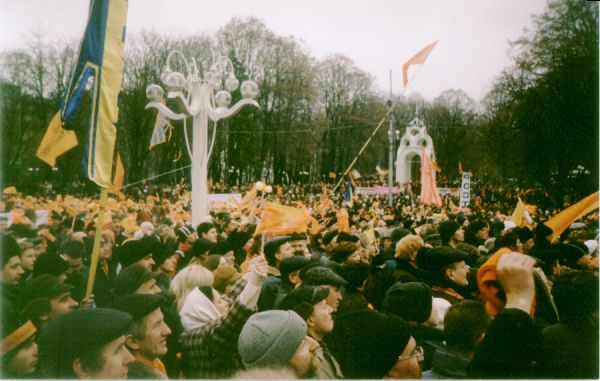
A peaceful demonstration in Kharkiv during the Orange Revolution
Photo by Anstan07 from Wikimedia Commons
By coining the term nedomystetstvo (недомистецтво: ‘anti-art’ or ‘under-art’), desperately trying to push artistic practices into the limited and thus convenient niche of ‘aesthetics’ and confine art’s role to a mimetic and beautifying one, Ukrainian society was fighting against itself, its phobias of maturing, of entering politics as an inalienable daily practice. Attempts to confine art to the niche where it ‘belonged’ were, in fact, mirroring the prevailing political practices of putting society in place.
The political emancipation of artistic practices was slowly opening doors to the political emancipation of Ukrainian society in general. It provided possibilities (albeit limited ones) to articulate and practice solidarity, participatory approaches, and activism; to address the issues of minorities and discrimination, power relations and hierarchies, freedoms and confrontations, censorship and open dialogue. Slow and embattled changes in vocabulary laid the groundwork for changes in social optics and, thus, for changes in practices of social interactions.
Without trying to draw a direct and exclusive connection between the emancipation of artistic and social practices in Ukraine from the 2000s to the early 2010s, it is nonetheless crucial to note this connection and its influence on the overall political agenda.
2004
As a movement of mass mobilization and emancipation, Maidan set art free from the constant need to fight for the political agenda, since everything has become a part of the political agenda. On the other hand, the rapidly accelerating dynamics of political and geopolitical changes in the country and the region brought several challenges for artists.
The unsurmountable force of the new and perpetually changing Ukrainian context was squeezed between newly acquired political freedoms and the devastating effects of war, between the overwhelming joy of getting one’s own country back and the daily growing death toll. This set a framework that was nearly impossible to avoid. Is it possible to be free in the choice of narratives, forms, and languages one engages with and still be relevant to the times one is living in? Is there a way to acknowledge society’s expectations and even demands for addressing burning political issues and still be critical and non-linear; acknowledge the thin edge of propaganda and, again, be free?
On the international scene, expectations and demands were not much different. In a way it was similar to what happened with the wider eastern European artistic context in the early 1990s, when local artists were in demand as ‘exotic’ representatives of the ‘wild’ post-communist east. After 2014 Ukrainian artists (as well as writers, filmmakers, and public intellectuals) were expected to fit into the pressing, and yet quite exoticized, niche of ‘post-Maidan art’.
The context proved to be inescapable and demanding. But why try to escape it in the first place? The new reality was raw for reflection and articulation, seeping through ruptures and multiplying conflicts, it was full of the unknown and unseen, and it protected itself through limitations, suppressions and bans. It was challenging, it was provoking.There was at least one major difference between the challenges of 2004 and 2014. Before 2014, politically engaged art sought to address universal democratic issues, long overdue in Ukraine, such as gender rights and equality, body politics, the politics of urban space and social cohesion, neoliberalism and power structures. Rooted in the local context and local needs, these attempts still strove to catch up with more universal, largely Western, art discourse. After 2014, the local context became the issue and the point of reference in itself.
Maidan marked a major resubjectification of a country previously absent on mental maps both international and, paradoxically, local. There were stories to be discovered and rearticulated. New narratives and representations were needed.
In a war-torn country, the war was obviously the primary story — though not only as a matter of life or death. It was war as geopolitical manipulation, as a factor of mass mobilisation, with a strong discriminatory and censoring backside. The memory wars and the one being waged on the past also came into focus.
If the first year, post-Maidan was marked by shows of Ukrainian art across Europe that dealt with the Revolution of Dignity, its martyrs (known as the Heavenly Hundred) and the onset of the war in a pretty straight-forward, almost therapeutic way (as, for example, ‘Through Maidan and Beyond’ at Architekturzentrum Wien). As timed passed, even though the intensity of events did not allow for proper distance, the narratives became more complex and multilayered.
There are two projects that reflect this complexity; their structure allowed for a more heterogeneous look at a multiplicity of issues. One is ‘The School of Kyiv: Kyiv Biennale 2015’, organized by the Visual Culture Research Center and curated by Vienna-based curators Hedwig Saxenhuber and Georg Schöllhammer. The other is ‘Today That Never Happened’, the First Festival of Young Ukrainian Artists, hosted in 2017 by Art Arsenal in collaboration with the National Art Museum and curated by Lizaveta German, Kateryna Filyuk, and Maria Lanko.
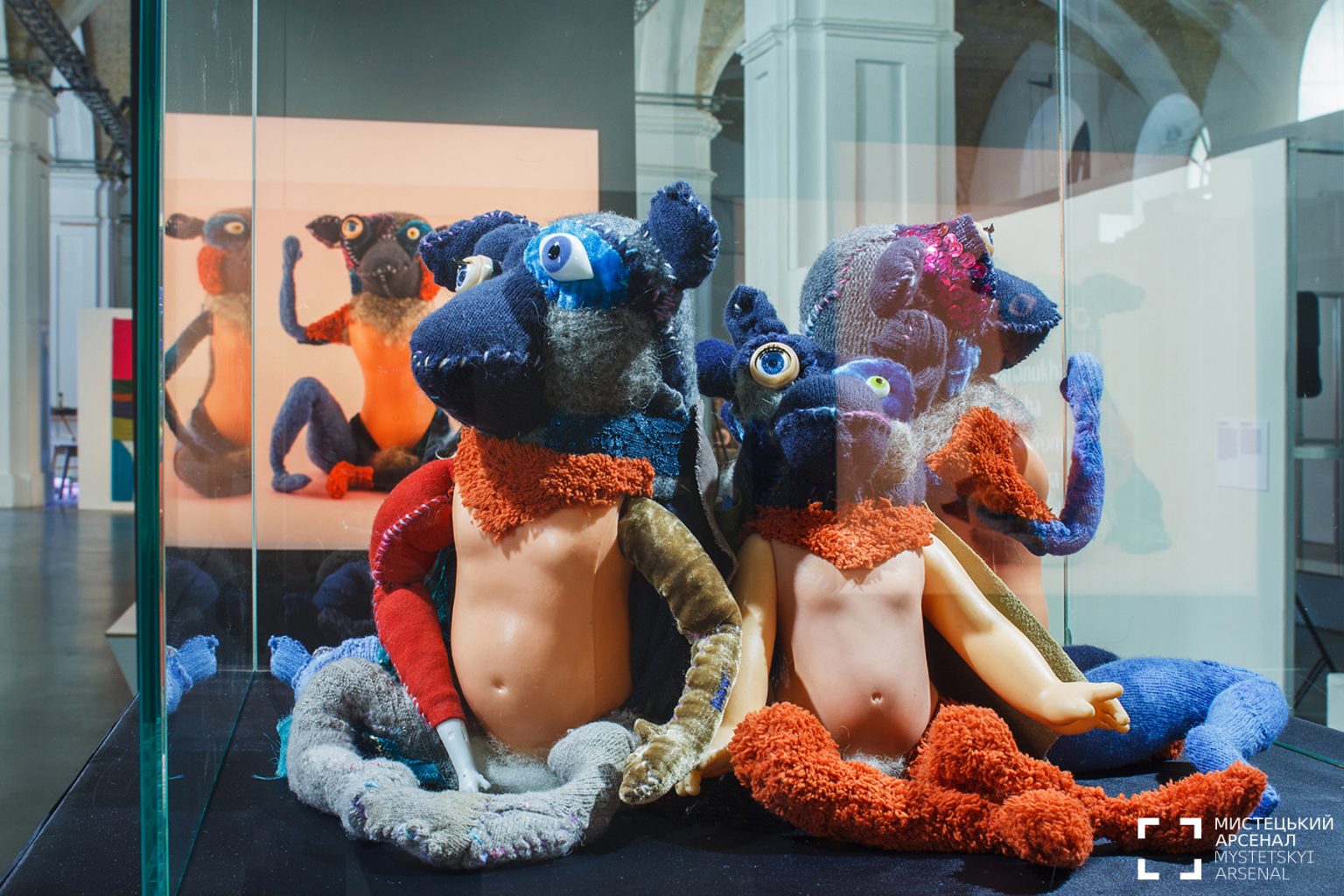
Artwork on display at the festival of young Ukrainian artists in Mystetskyi Arsenal. Photo via and courtesy of Mystetskyi Arsenal.
The Kyiv Biennale was itself a conflicting project. Art Arsenal, the largest publicly-funded cultural institution in the country, held the first edition in 2012, a spectacular show curated by David Elliott. By the next edition, first planned for 2014 and then postponed due to the country’s political turmoil, the institution entered into a financial and conceptual battle with the two invited curators, which almost resulted in the event’s cancellation. Then the Biennale was picked up by VCRC, a small non-profit institution, itself once displaced (over ‘Ukrainian Body’, as explained above). Notions of place and displacement, as well as representation and misrepresentation, played a major role in The School of Kyiv. Conceived as a platform for mutual learning, dialogue, and experiences, it was scattered between fourteen locations throughout the city and structured around six schools: The School of Abducted Europe, The School of Landscape, The School of Realism, The School of the Displaced, The School of the Lonesome, and The School of Image and Evidence.
It was not only Ukrainian experiences that were put in a wider context through these visual and discussion platforms, however. They allowed for more elaborate ways of addressing the issues of the post-colonial gaze (not only in the post-Soviet realm, but in the European space as well), displaced people and migration (which Ukraine was witnessing en masse for the first time, due to the war), political euphoria and frustration, disinformation and representation.
The Young Artists Festival, on the other hand, was a case of a major turn in public policy. For the first time, contemporary critical art was treated as a legitimate and even crucial medium for reflecting contemporaneity. Public institutions and governmental bodies that used to see heritage and history as their main focus of attention and funding now accepted the existence of a discourse that was radically different and inherently critical. History was happening now, and it had to be articulated and represented.
So the curators set out to look at questions of what it meant to live in times like those Ukraine was going through. Though spread between several parallel locations (the National Art Museum, hotels, and artist-run spaces), the main exhibition in Art Arsenal developed its narrative along the lines of war and internal displacement; alternative ways of cohabitation as seen through the gaps in urban structures; the deconstruction of power hierarchies confronted but also restructured in a country living through never-ending aggression; the figure of the artist as someone provoking or disrupting public peace; artistic appropriation; and hidden histories.
The next festival, held in autumn 2019, took place in Kharkiv. This symbolizes yet another important transformation of which contemporary art is a major part: rediscovering and reevaluating localities in a country as vast and as traditionally centralized as Ukraine. The earnest but temporary unity of geographically and ideologically diverse forces during Maidan was subsequently confronted by geopolitical splits in the east of the country, which were presented as irresolvable cultural struggles and toppled with vast and brutal policies of decommunization. Ukraine, a country with a complex and largely unarticulated history, rapidly entered the era of memory wars, joining its neighbours to the east and west with a slight delay.
Numerous artistic projects and initiatives that emerged after 2014 sought to research, articulate, and often preserve local stories and histories. The scope of those projects runs from artists’ walks and voyages across the country to collaborations with and the reconceptualization of local history museums in small towns, research residencies, activist campaigns, and the opening of cultural hubs and platforms in places the names of which, until recently, were known to few people.
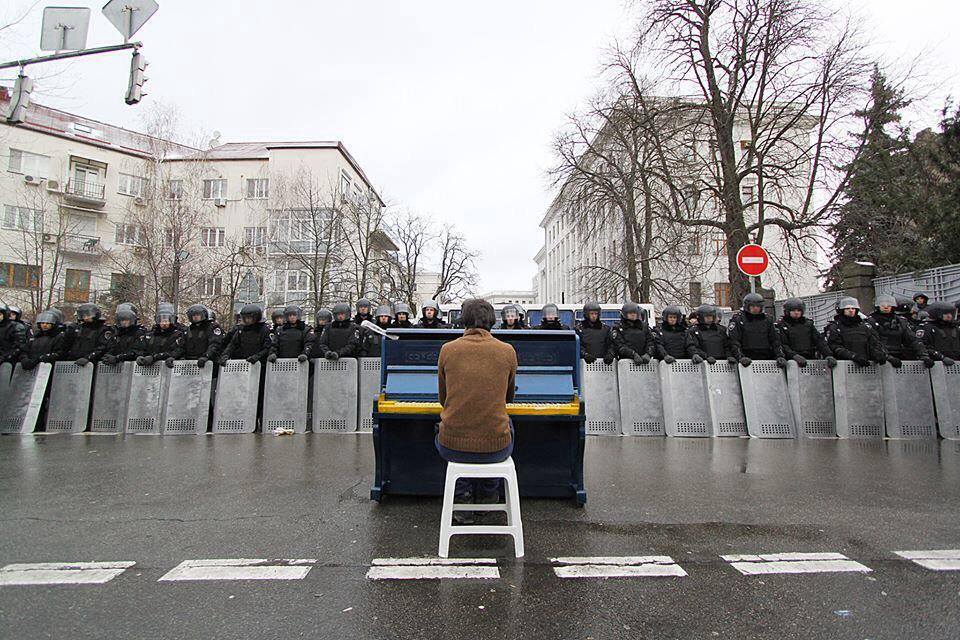
Pianist plays ‘Imagine’ by John Lennon on the anniversary of his death to riot police. Photo by Nastya Stanko via Maidan translations
2019
After 2014, the surge of initiatives and artistic reflections emerged from the need to regain authority and retain the capacity for critical thinking and representation in times of major disruptions, from the need to rearticulate art as political practice in times when everything was highly politicized. Yet, to a large extent, that surge was also based on hope: the big, beautiful, and consciously naive hope that the tragedy of the war that was far away but still painfully close, which shook the very foundations of the feeble social contract and let the manipulations of power through its cracks, will come to an end. But it did not.
In the new political reality, between memory wars and deepening cultural divides, xenophobia and ideologically vague but politically confident populism, disinformation, and manipulations, not to mention the smouldering conflict in the east that does not have any vision of coming to an end, art is yet again confronted with the futility of its own political aspirations. These political realities and limitations bring the Ukrainian context much closer to that of eastern Europe than it has ever been, making the artists face an increasing multiplicity of possible roles: visionary, post-artistic practitioner, utopian thinker, creator of possible scenarios of the future, fighter, mediator, dreamer, blade runner… More to come.
This essay is based on the author’s contribution to the catalogue of the 2019 exhibition titled Between fire and fire: Ukrainian art now organized by the Ukrainian Institute in collaboration with Zenko Gallery (21 September-8 October 2019).
http://vcrc.org.ua/en/ukrbody/
Published 6 February 2020
Original in English
First published by Between fire and fire: Ukrainian art. Exhibition catalogue (2019)
© Kateryna Botanova / Vienna Ukrainian Institute / The Institute for Human Sciences / Eurozine
PDF/PRINTIn collaboration with
In focal points
- Not epistemic enough to be discussed
- Another lost generation of art?
- A trace of Russia at the heart of Austria
- What makes a humanist kill?
- Something happens, somewhere
- Vertical occupation
- No longer a footnote
- The Ides of March
- Counteroffensive exhibitions
- No peace without freedom, no justice without law
Newsletter
Subscribe to know what’s worth thinking about.
Related Articles

An emotive rift exists between being drafted and signing up for military service. Those who prioritize family responsibilities, education and skills, and non-violence aren’t backing the opposition. Defence comes in many forms. Could lessons from Ukraine’s mobilization inform the recruitment challenges potentially facing the rest of Europe?

For those who suffered the consequences of Yalta’s division of Europe, the Helsinki Final Act brought grounds for optimism. Today, as Russia’s regressive war on Ukraine reopens old conflicts, it stands as a monument to European modernity.
